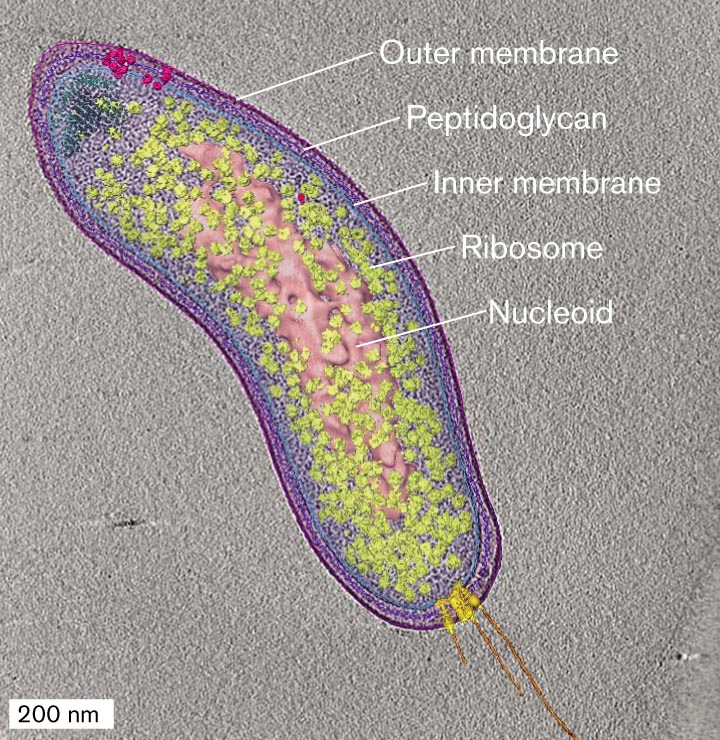Cell Structure and Function

More information
A micrograph of Bdellovibrio bacteriovorus with several internal structures identified. The bacterium is about 1200 nanometers long and 300 nanometers wide. A flagellum is visible at one end of the bacterium. A thin outer layer around the cell is identified as the outer membrane. Internal to the outer membrane, a slightly thicker layer is labeled as peptidoglycan. A thin layer borders the peptidoglycan and is labeled as the inner membrane. Within the cell an oblong irregular structure is identified as a nucleoid. Above and around the nucleoid are several small circular structures identified as ribosomes.
Bacterial predator in 3D. A Gram-negative bacterial cell, Bdellovibrio bacteriovorus, was flash-frozen and imaged by cryo-electron tomography. B. bacteriovorus is a predatory bacterium that attacks Escherichia coli and is under development as a biological therapy for infections by a pathogenic E. coli strain. Source: Oikonomou, C., Chang, YW. & Jensen, G. A new view into prokaryotic cell biology from electron cryotomography. Movie 1. Nat Rev Microbiol 14, 205–220 (2016). https://doi.org/10.1038/nrmicro.2016.7DR. GRANT JENSEN
Cryo-electron tomography of an intact Bdellovibrio bacteriovorus cell
|
Chapter Sections |
Learning Objectives |
|
|
» |
Describe the overall form and function of a bacterial cell and its major compartments. Explain how bacterial cell structures are studied in the lab. |
|
|
» |
Identify the key features and functions of cell membrane components, including phospholipids and proteins. Explain how the bacterial cell membrane interacts with small molecules. |
|
|
» |
Describe the structure of different types of cell envelope, including the cell wall and Gram-negative outer membrane, and explain how the cytoskeleton maintains cell shape. |
|
|
» |
Explain how a bacterial cell coordinates DNA replication with cell expansion and septation during the process of cell division. |
|
|
» |
Explain the role of asymmetry and polarity in cell form and reproduction, and describe how bacterial cells extend their contents using vesicles and membrane extensions. |
|
|
Special Topic 3 Bacteria Reach Out with Pearling Tubes and Nanopods |
||
|
» |
Describe the function of various subcellular structures found in particular taxa, such as carboxysomes, attachment pili, and flagellar motors. |
|
To grow and multiply, a microbial cell must obtain nutrients faster than its competitors do—or else share nutrients for mutual advantage. At the same time, each cell’s envelope must exclude toxicants such as your intestinal bile salts. To manage all these survival tasks, microbes have evolved an amazing set of molecular parts, from rotary flagellar motors to crystalline compartments that sequester CO2. Cell extensions communicate with other cells and even exchange nutrients with fellow bacteria.
A bacterial cell contains surprising devices, such as a receptor array that acts like a “nose” to find food and motorized flagella to swim toward it. Unlike eukaryotes, a bacterium continually builds new parts while copying its DNA in time for cell division. This process requires an extraordinary ballet of proteins that form a “Z-ring” around the equator, while other proteins pulse back and forth from one pole to the other. These molecular dances appear in different colors under fluorescence microscopy, as we learned in Chapter 2.
For biotechnology, every part of a bacterial cell may be of use. Bacterial cell parts provide targets for antibiotics and vaccines. They offer tools for engineering, such as DNA polymerase and molecular motors. They provide models for design, such as thylakoids packed with chlorophyll as models for solar devices.
Chapter 3 explores the most common cell parts and functions of many species of bacteria and archaea. Further cell forms are explored in Chapter 18 (bacteria) and Chapter 19 (archaea). Microbial eukaryotes are presented in Chapter 20.
